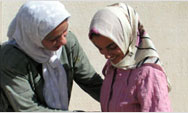You are here » Home » Telling Our Story
Success Story
Program trains women on local, traditional craft
of raising silkworms
Women Revive a Thread to Silk Road

Photo: USAID/Afghanistan: Kim Kim Yee
Members of a silkwork production program in northern Afghanistan display their silk-
embroidered handiwork.
“I am very pleased to see all of these beautiful products have been made by the women of Sari Pul,” said Aziza Jalis, head of the Sari Pul Department of Women’s Affairs.
The women of Sari Pul Province in northern Afghanistan remember how, as little girls, their mothers taught them how to care for silkworms, and how to make hats, “chapans” (traditional male overcoats), and embroideries from their threads. The ancient Silk Road once passed through northern Afghanistan, wending its way near the great Amu Darya River, which now serves as Afghanistan’s northern boundary. As the traders passed through, they brought not only goods, but also new skills and crafts, such as sericulture (the commercial breeding of silkworms for their silk).
Yet years of fighting and drought nearly destroyed this art, once common in these villages. The supply of silkworm eggs, once supplied by the Department of Agriculture, came to a sudden halt. The introduction of factory-made synthetic materials replaced the demand for silk products. Additionally, many households left Sari Pul for security reasons, taking with them the knowledge of traditional silk crafts.
USAID is helping to revive the craft, which is also creating additional sources of income for Afghan families. As part of the project, the nearby Mazar Sericulture Department office and silkworm raising facilities were reconstructed. Women from six villages in the district were organized into groups, each of which received rearing kits. Eight village monitors were selected, who monitored silkworm growth, trained, and advised other participants. The Mazar Sericulture Department conducted training on silkworm growing methods.
Within three months, the process resulted in 342 kilograms (more than 750 pounds) of dry cocoon. Silk reeling training then began, turning these cocoons into silk thread. These women have started to produce silk-embroidered products, such as cushion covers, curtains, and “joinamaz” (prayer mats). Eight months after receiving the silk worms, the women displayed the handmade silk products at an exhibition held at the Sari Pul Department of Women’s Affairs (DOWA). “I am very pleased to see all of these beautiful products have been made by the women of Sari Pul,” said Aziza Jalis, head of the Sari Pul DOWA. “I am very proud of them.”
Print-friendly version of this page (533kb - PDF)
Click here for high-res photo
Back to Top ^ | 

